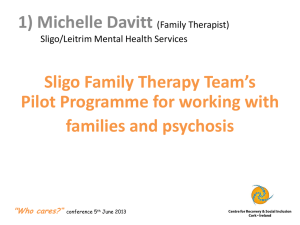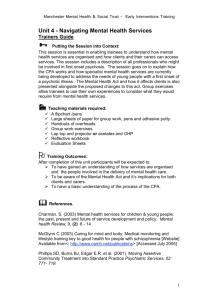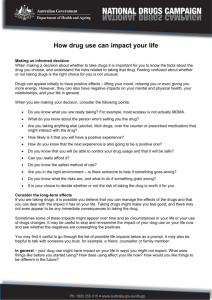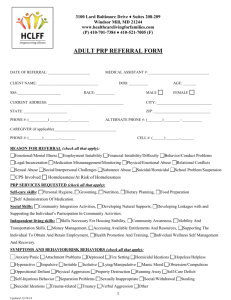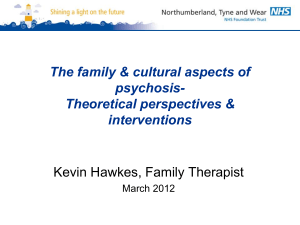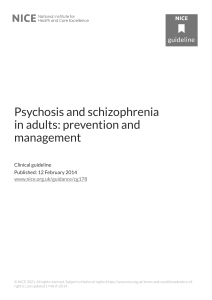Common Experience vs. Intended Result of Early Psychosis
advertisement
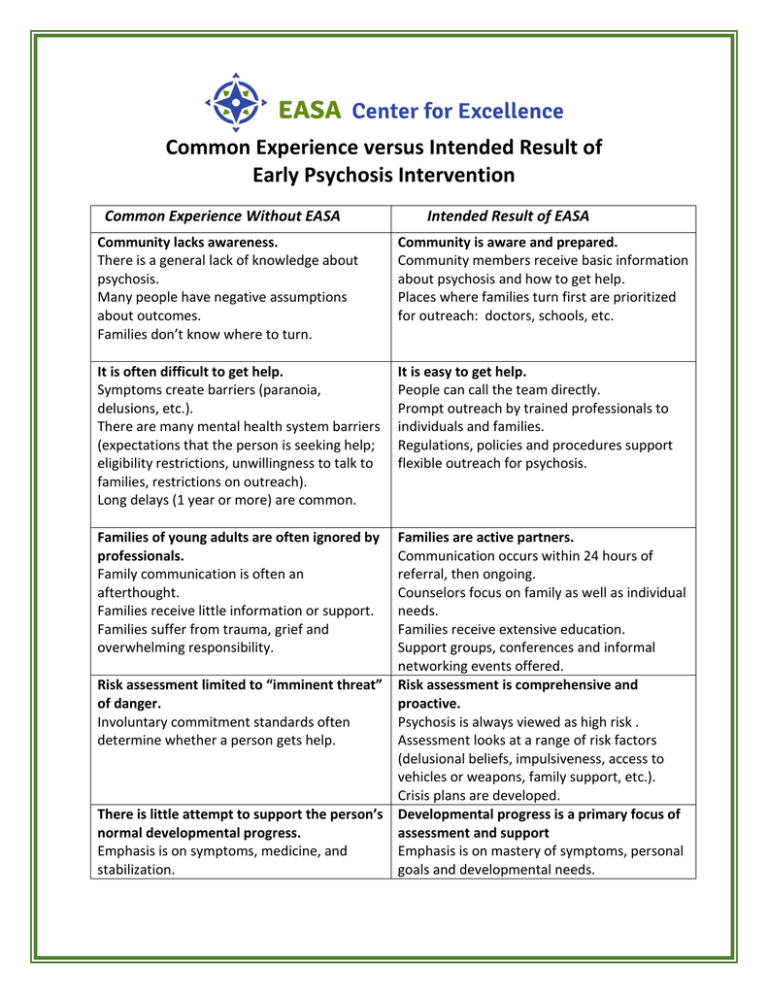
Common Experience versus Intended Result of Early Psychosis Intervention Common Experience Without EASA Intended Result of EASA Community lacks awareness. There is a general lack of knowledge about psychosis. Many people have negative assumptions about outcomes. Families don’t know where to turn. Community is aware and prepared. Community members receive basic information about psychosis and how to get help. Places where families turn first are prioritized for outreach: doctors, schools, etc. It is often difficult to get help. Symptoms create barriers (paranoia, delusions, etc.). There are many mental health system barriers (expectations that the person is seeking help; eligibility restrictions, unwillingness to talk to families, restrictions on outreach). Long delays (1 year or more) are common. It is easy to get help. People can call the team directly. Prompt outreach by trained professionals to individuals and families. Regulations, policies and procedures support flexible outreach for psychosis. Families of young adults are often ignored by professionals. Family communication is often an afterthought. Families receive little information or support. Families suffer from trauma, grief and overwhelming responsibility. Families are active partners. Communication occurs within 24 hours of referral, then ongoing. Counselors focus on family as well as individual needs. Families receive extensive education. Support groups, conferences and informal networking events offered. Risk assessment limited to “imminent threat” Risk assessment is comprehensive and of danger. proactive. Involuntary commitment standards often Psychosis is always viewed as high risk . determine whether a person gets help. Assessment looks at a range of risk factors (delusional beliefs, impulsiveness, access to vehicles or weapons, family support, etc.). Crisis plans are developed. There is little attempt to support the person’s Developmental progress is a primary focus of normal developmental progress. assessment and support Emphasis is on symptoms, medicine, and Emphasis is on mastery of symptoms, personal stabilization. goals and developmental needs. Negative assumptions about schizophrenia predominate. Professionals are quick to assume and communicate that the person will be unable to live a normal life. The treatment process is often coercive. Disagreements are labeled “non-compliance”. People are given directions and expected to follow. Clinical language is used. Individuals and families often receive little information about their illness and methods of coping. High doses of medicine are common. Side effects lead to decreased functioning and choice to stop taking medicine Services focus on keeping people who have long-term needs out of the hospital. Work and school are often discouraged as a “high-stress” activity. A minimal level of functioning is accepted. Group activities mix people with long-term negative outcomes with young people. People in recovery play little or no role in service design. Positive, realistic assumptions about schizophrenia predominate. Emphasis is on successful ongoing management of symptoms and movement toward personal goals. Professionals communicate the expectation that with an active recovery process the person can have a fulfilling life. People are given the chance to meet successful role models. Personal choice is always sought and respected. Relationships are built on self-identified goals and needs. Professionals build on the person’s interpretations and language. Honest communication about choices is encouraged. Information to help improve choices is provided. Individuals and families receive extensive information about the illness, symptom management, and successful recovery. Medicine is normally prescribed at low doses and gradually tapered up as needed. Careful attention is given to symptoms and side effects. Services focus on helping people move on with their lives while learning the skills to stay out of the hospital. A strong focus is placed on vocational and educational support Individuals are encouraged to learn about relapse planning, workplace accommodations, etc. Groups and activities specifically for young people are provided. People in recovery provide oversight, feedback and direction for service design.

